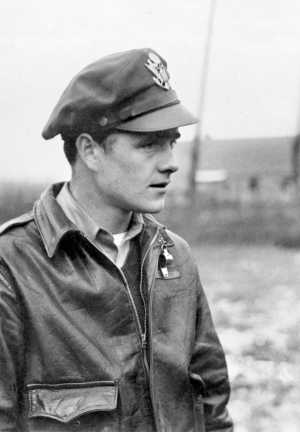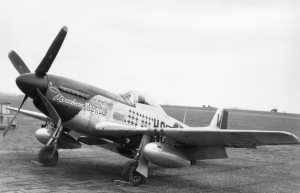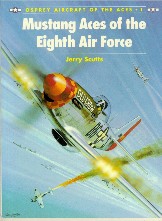USAAF ETO Aces of WW2
More P-51 Mustang Aces
By Stephen Sherman, June, 1999. Updated December 14, 2016.
| Mustang Aces Biographies and Combat Stories: | ||
| Duane W. Beeson | Robert W. Foy | |
Duane W. Beeson
Born 1921 at Boise, Idaho. Duane enlisted in the Royal Canadian Air Force in 1941, assigned to RAF 71st "Eagle" Squadron, later transferred to 334th Squadron, 4th FG/8th USAAF. Nicknamed "Bee", he decorated his aircraft as "Boise Bee." Beeson was one of the few 4th FG pilots to achieve real success in the P-47, scoring 12+ victories in the Thunderbolt. He was promoted to CO of the 334th Squadron on March 15, 1944. He scored his remaining kills in a P-51 Mustang. Like Dick Bong, Beeson was a consistent fighter pilot, scoring single (or double) victories many times. From May 18, 1943 through April 5, 1944, Major Beeson shot down German planes on 15 different occasions, scoring most heavily in early 1944 over Germany itself. All but one of his kills were against single-engine fighters (FW-190s and Bf-109s).
On April 5, 1944, in his own words: "Our group was strafing aerodromes near Berlin. We had left one drome behind with many burning Ju-88's on the ground when another was sighted, so we went in to attack it. There were five Ju-88's parked wing-tip to wing-tip along the perimeter track, so I opened fire on them. The first one burst into flame and there were strikes all over the others, so I picked a big-assed Me-323 to shoot at next. Just as I opened fire and began to see some results, tracers flashed past my cockpit and my Mustang was hit. Leaving the aerodrome behind I climbed to 1,000 ft. and tried to get the engines running again but had no luck so decided to get out. Had lost altitude down to 400 ft. when I finally shoved the stick forward and bunted my way out of the a/c. The chute opened just in time to carry me over a fence and deposit my carcass in a field surrounded by many members of the "Super Race" -- including one blonde fraulein on a bicycle." He spent the next thirteen months as a POW.
Victories: 24.25; 19.5 air, 4.75 ground. He earned
the Distinguished Service Cross, Silver Star, Distinguished Flying
Cross,
Air Medal, and many other decorations. Duane was promoted to Lt. Col.
after
the war and died of a brain tumor 15 Feb 1947. He is interred at
Arlington
National Cemetery.
Sources:
- www.fourthfightergroup.com - a lot more info on all aces of the 4th FG at this terrific site
- United States Army Air Force Legends
- Jerry Scutts, Mustang Aces of the Eighth Air Force, Osprey Publishing, 1994
Leonard 'Kit' Carson
Top scorer of the 357th Fighter Group with 18.5 victories (plus 3.5 more by strafing). Formed at Tonopah, Nevada, the 357th was the first P-51 equipped unit in the Eighth Air Force, beginning combat operations in February 1944. Its aircraft were among the most colorful, with red and yellow nose checkers and a variety of nicknames and nose art.
Carson was on the verge of heading for the Pacific with a P-39 outfit, but instead joined the 357th. His first victory was on April 8, 1944. His chosen technique for success was to bore in close to his victim, rather than rely on deflection shooting. He chalked up the bulk of his score during the final six months of the war, flying Nooky Booky IV. He ran 'Clobber College' the 357th's combat school, for a time, passing on his skills.
When training, he emphasized the challenges of flying seven-hour missions in the harsh weather of Northwestern Europe. He stressed the importance of the "two-ship" element, and the defensive strengths of the P-51. "Do anything you can to break his line of sight on you. Once you've done that, he can't lay a glove on you." He insisted that the new pilots master instrument flying, a necessity in the rain, snow, ice, and poor visibility of the ETO. "Anyone who has a casual attitude toward flying in this climate is going to wind up wearing an 8,000 pound coffin at the bottom of the North Sea." He noted that they should all become intimately familiar with the east coast of England, as the biggest aid in zeroing in on home base.
For gunnery, he encouraged the new pilots to close in
from behind, noting the difficulties of deflection shooting. "Get dead
astern and drive in to 200 yards or less, right down to 50 yards and
fire
a couple of one-second bursts." He told the pilots to think about six
and
seven hour missions, and to dress as if they "were going to have to
walk
out of Germany."
Sources:
- Jerry Scutts, Mustang Aces of the Eighth Air Force, Osprey Publishing, 1994
John Godfrey
He scored 18 victories with the famed 4th Fighter Group.
December 1, 1943 - John Godfrey got his first kill, a Bf-109, in a fairly uneventful bomber escort mission to Solingen, Germany.
March 8, 1944 - The Group was again back to Berlin. They found the B-17s near Gardelegen, Germany and relieved the escorting P-47s. The first German attack was by Bf-109s and was intercepted with 3 enemy aircraft destroyed. Then 60 plus approached and attacked in pairs and groups of four. Combat raged all over. Several B-17s went down and parachutes dotted the sky. Most of the Group got trapped east of Berlin and forced the pilots to fly onto Russia. This was the first time that Don Gentile and John Godfrey teamed up. They knocked down six between them, making Godfrey an ace. This also tied Gentile with Duane Beeson at 14 and began their famous scoring race.
April 22, 1944 - Colonel Blakeslee led a Fighter Sweep to Kassel-Hamm, Germany. As they passed Kassel at 18,000 feet, 20 plus Messerschmitts were spotted 12,000 feet below. The Group bounced the Germans after orbiting to lose altitude. Several of the Bf-109s attempted to shake the Mustangs by doing aerobatics right on the deck but the Group picked off one after another. Willard Millikan managed to shoot down four 109s. John Godfrey got three.
August 5, 1944 - John Godfrey returned from leave in the U.S. on July 24 and was up for the first time since to down a Bf-109 in the air and three Ju-52s on the ground. Fred Glover got a 109 also.
August 24, 1944 - The Group was on a penetration target support mission to Misburg and then on a target withdrawal support to Merseburg, Germany. John Godfrey and a few other 336th pilots strafed an airfield. Godfrey got four Ju-52s, Melvin Dickey got three and Pierce Wiggin got one. As they worked over the field, Godfrey's plane was hit and he was forced to belly in. He was captured and spent the rest of the war as a POW. It was later determined that Dickey, Godfrey's wingman, shot Godfrey down by accident.
Godfrey died of Lou Gehrig's disease in 1958.
Sources:
- www.fourthfightergroup.com - a lot more info on all aces of the 4th FG at this terrific site
- Jerry Scutts, Mustang Aces of the Eighth Air Force, Osprey Publishing, 1994
Lt. Col. John B. England
Lt. Col. John B. England was born January 15, 1923, at Caruthersville, Missouri. He enlisted in the military as a private in April 1942, and after attending aviation cadet training, he was commissioned and assigned as a fighter pilot. In November 1943, he was assigned to the 357th Fighter Group, 8th Air Force in Great Britain, where he took part in 108 combat missions for a total of 460 combat hours in the North American P-51 Mustang.
During his tour in Europe, Colonel England destroyed 19 (17.5 air) German aircraft and, on one mission, destroyed four enemy planes. For this gallantry in action, he was awarded the Silver Star. He owed part of his success to the technological advances incorporated into the P-51: the K-14 gunsight and the G-suit. On September 13, 1944 he was leading 'Dollar Squadron' (the 362nd FS) at 8000 feet when he spotted a Bf-109 in a dive. It was soon overhauled as England closed to 800 yards at an altitude of 3000 feet. Seeing that his quarry was heading for an airfield, England wound his P-51 up to 400 mph and turned tightly to close the range to 500 yards. With the K-14 (deflection-compensating gunsight) locked on, England fired, and saw the strikes on the Bf-109's engine and cockpit before it crashed. He went on to down two more Bf-109s that mission.
He was also awarded the Distinguished Flying Cross with
three oak leaf clusters and the French Croix de Guerre. Colonel England
returned to the United States in February 1945 and served with the Air
Force until his death in 1954. Returning from a training flight in his
F-86 "Sabre" aircraft November 21, 1954, Colonel England was killed
while
attempting to land at Toul Air Base, France. With the choice of trying
to get over the barracks for a landing or swerving away for certain
death,
he choose the latter rather than risk sending other persons to their
death.
He turned left and crashed. Alexandria Air Force Base was renamed
England
Air Force Base June 23, 1955 in honor of Colonel England.
Sources:
- Jerry Scutts, Mustang Aces of the Eighth Air Force, Osprey Publishing, 1994
Robert W. Foy
363rd Fighter Squadron, 357th Fighter Group, 15
aerial and 3 ground victories. He flew two P-51Ds nicknamed Reluctant
Rebel and Little Shrimp. Foy enjoyed something of a charmed
life, being plucked out of the Channel twice, and even managing to fly
home after hitting a tree during a low flypast of a downed foe. Foy
ended
the war as a Major.
Sources:
- Jerry Scutts, Mustang Aces of the Eighth Air Force, Osprey Publishing, 1994
Ralph 'Kid' Hofer
Hofer scored 15 wins with the 334th FS of the 4th Fighter Group. He was tall and powerfully built; it was difficult to reconcile his frame with his chronic smile and guileless manner. He let his hair grow into a chestnut mane and he wore a snake ring and a blue & orange football jersey with the number 78 on it.
Hofer commenced bagging Huns as unceremoniously as he had enlisted in the RCAF. It was an accepted axiom that a pilot flew 10 or 11 missions before his eyes were good enough to even see a Hun, let alone bag one. But Kid Hofer bagged a 190 on his first mission and astonished all by gaily diving down to strafe a flak boat in the Channel. The veterans said pilots could not get a Jerry the first trip, but Hofer had combat film to show for it. It didn't take him long to become the only Flight Officer in England with five swastikas on his kite.
Hofer appeared to have a gay disregard for all the dangers European skies held. No other pilot in the group would prowl about there without a wing man, and preferably a squadron. Not so Hofer, who was out to see how many Huns he could bag. He got a bang out of the Salem Chamber of Commerce passing resolutions eulogizing his part in the global war and the newspaper clippings. One day he had to turn back from a mission because a wing tank wasn't feeding, but his mechanic quickly fixed it and Hofer took off before he was checked in. He took a spin around Holland and Belgium, scouring for Huns and blazing away at flak posts in the Zuider Zee. On his return he saw Lt. Col. Clark bouncing over the grass towards his plane. "I'm in for it now," Hofer murmured to his crew chief.
"Where the hell you been, Hofer?" Clark angrily asked.
"Sir, I had to turn back," said Hofer.
"But these guns have been fired. Explain that."
"Oh, that, sir, I -- well, I did that before I aborted," said Hofer. Another time he was on the tail of a Jerry blasting away. He could see the half-inch slugs ripping into the Hun, but the Hun suddenly pulled away and left him, for Hofer had used up the gas in his fuselage tank and had forgotten to switch over to his wing tanks. Meanwhile, another pilot whipped in and opened fire on Kid Hofer's Hun.
"Break! Break!" shouted Hofer.
The pilot, led to believe that a Jerry was barreling in on his tail, broke sharply to port and Hofer zoomed in to resume his firing and destroy the Hun.
On the June 26 shuttle mission, he flagrantly disobeyed
Blakeslee's orders, and chased a German fighter to the deck; he failed
to rejoin. He navigated to Kiev on his own, and rejoined the Group. On
the return, he again disobeyed orders to go off on his own, this time
rejoining
the Group in Sicily. From here, Blakeslee organized a combined Fighter
Sweep with the 352nd and the 325th. On this mission, Hofer was shot
down
and killed over Mostar, Yugoslavia. He was credited with 15 kills
in
the air, and 15 more on the ground.
Sources:
- www.fourthfightergroup.com - a lot more info on all aces of the 4th FG at this terrific site
- James Goodson, Tumult in the Clouds, St. Martin's Press, 1983
- Jerry Scutts, Mustang Aces of the Eighth Air Force, Osprey Publishing, 1994
Donald Bochkay

He flew with 363rd FS of the 357th Fighter Group. He scored 14.8 (13.5?) air-to-air victories (10.5 in Mustangs), the top ace of this group, the last victories being a trio of Fieseler Storches. Don Bochkay frequently flew as part of a flight of four pilots that included Jim Browning (7.5 wins), Chuck Yeager (11.5), Bud Anderson (16.25), and Bochkay himself. Major (from March 1945) Bochkay planned and led a number of successful missions against German jet bases during the closing weeks of the war, downing two Me-262s. His last three aircraft were all unnamed, but carried has large "winged ace" insignia on the engine cowlings. Bochkay was not credited with any air-to-ground victories.
But he was credited with the most memorable line uttered by any Eighth Air Force pilot in World War Two. He had managed to obtain some silk underwear, and was using the lure of the fine lingerie to impress an English barmaid. "Stick with me honey, and you'll be farting through silk."
- 1940 - Member of US Infantry
- 1941 - Applied and accepted as an aviation cadet, class 43D
- 1943 - Received Pilot's wings and assigned to 357th Fighter Group
- 1944 - Entered combat with 363rd Squadron
- 03-05-44 - Berlin Escort Mission: FW-190 FIRST VICTORY! (shared) + (2) Me110
- 04-08-44 - Brunswick, Germany: Bf-109 attacking lagging B-24 -Victory
- 04-12-44 - Hanover, Germany: Bf-109 diving for cover -Victory
- 04-24-44 - Munich, Germany: Bf-109 Victory
- 06-29-44 - Brunswick, Germany - Flight was bounced from above, Bf-109 Victory
- 07-05-44 - Rouen, France: Two FW-190 Victories
- 07-25-44 - Paris, France: Met 20 Bf-109's head on, Bf-109 victory with two bursts.
- 07-29-44 - Merseberg, Germany: FW-190 attacking straggler - victory
- ? - On leave to United States, then returned to 363rd FS, 357th FG
- 12-05-44 - NW of Berlin: Two FW-190 Victories
- 02-09-45 - Fulda, Germany: Me-262 Victory!
The Me-262's could fly at 540 MPH and no Mustang could catch them. The catch was they had to slow down to fire on the slow-moving B-17s unless they slowed down. And when they did, they weren't nearly as maneuverable as a Mustang. Don Bochkay and Jim Browning caught one that made this mistake. Bochkay turned inside the jet and shot up one of its under-wing engines. The Me-262 fell to earth, but unfortunately Browning disappeared too.
- 04-18-45 - Prague, Czech: another Me-262 Victory.
Record - 123 Combat Missions, 510 Combat Hours, 13.83 victories in P-51
Post War - Civilian until 1956 when he rejoined USAF, retired as a
Lt. Colonel.
In 1970 Don Bochkay visited Leiston, the 357th's base, and wrote this
letter, which appeared in Bud Anderson's To
Fly and Fight: Memoirs of a Triple Ace:
Dear Zack,He died unexpectedly in February 1981.
If you go to England and on to Leiston, don't be too disappointed in what you don't see there. I was there on our base in 1970. I was looking for a door off our hut that had a record of kills for Yeager, Browning, Anderson, Peters, and myself. Burned in with a hot poker.
I would have given $500 for that door. I didn't find it. I still have a hunch it exists.
Our base at Leiston was being chewed up by a concrete eater when I drove up un one of the runways. No one but us knows the feeling that went through me when I drove up on the active runway to see the big monsters destroying our base.
I relived a thousand days as I looked down that main runway, (thought) of boys who became men and did what they had to do, men who backed them to the hilt with their skills to make it possible.
I shed my tears at Leiston when I was there in '70, and I will remember it forever.
Have a good trip if you go to Leiston, and don't be ashamed to cry.
Yours, Don
Sources:
- Jerry Scutts, Mustang Aces of the Eighth Air Force, Osprey Publishing, 1994




